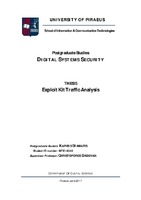Exploit Kit traffic analysis

Master Thesis
Author
Καπίρης, Σταμάτης
Kapiris, Stamatis
Date
2017-06Advisor
Νταντογιάν, ΧριστόφοροςView/
Keywords
Malware analysis ; Security ; Trafic analysis ; PLAP network ; Exploit KitAbstract
Exploit kits have become one of the most widespread and destructive threat that
Internet users face on a daily basis. Since the first actor, which has been
categorized as exploit kit, namely MPack, appeared in 2006, we have seen a new
era on exploit kit variants compromising popular websites, infecting hosts and
delivering destructive malware, following an exponentially evolvement to date.
With the growing threat landscape, large enterprises to domestic networks, have
started to adopt multiple security solutions to guard their perimeter against them.
An exploit kit is actually a type of malicious toolkit that is used to identify and
exploit security holes found in web browser plugins installed on victim’s computer,
for the purpose of facilitating the real aim of spreading and infecting the computer
with a type of malware. Exploit kit authors have been proven quite skilled
programmers of crimeware which embodies sophisticated code and
characteristics considered as challenging in terms of analysis and detection, for
both security controls and analysts.
In this thesis, we will try to examine the exploit kit phenomenon and cover all
perspectives. First of all, we will explain the motivating factor of studying this
subject and refer to cybersecurity researchers’ previous work regarding exploit kit
analysis. We will also refer to cyber security incidents of the past having as main
actor an exploit kit and describe their infrastructure and business model they
usually follow for profiting from their underground activity. To familiarize the
reader with the exploit kits, we will discuss the ways of propagating themselves
and describe and analyze their main characteristics that can be categorized as
attack characteristics and self-defense characteristics. We have also covered the
procedure of analyzing network traffic captures that contain traffic produced by
exploit kits, so as to give a walkthrough to the researchers who will be interested
in performing a basic malware traffic analysis.
Finally, we designed a simple command line script that takes as input a packet
capture file that contains network traffic captured during live infection by exploit
kit, parses the packets according to the exploit kit theory that is described in this
thesis, to indicate in turn, the potential attack path the actor followed to
compromise the victim. Our code is based on the results of our research and our
observations by analyzing many malware samples. It would be possibly useful for
a researcher who wants to a quickly identify a starting point to begin his analysis
of samples containing exploit kit traffic.


